Muntz Metal Co
(c) Antique Metalware Society
Small extracts can be used with acknowledgements to 'Oldcopper.org' website.
Helpful comments are very welcome.
Muntz Metal Co., Elliot Road, Selly Oak, Birmingham, started c1829 as G F (George Frederick) Muntz of Water Street, Birmingham, then (from 1842) French Walls Works, Alma Street, 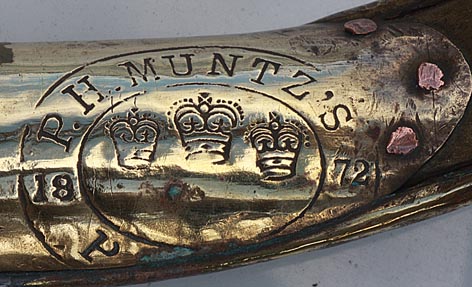 Smethwick, Staffordshire. George Muntz's 1832 patent for 60/40 brass ship sheathing sheet was the basis of the firm's success. The alloy is excellent for casting and can be hot rolled to a relatively thin gauge. With a high content of zinc, it is cheaper than pure copper. It was specified for the restoration of the 1869 'Cutty Sark' tea clipper in London. Stocks of copper and brass sheet were held near important ports, especially in India. It was available for general use and the Muntz name appears on many domestic products. This P H (Phillip Henry) Muntz mark is on a tambourine made of the later Muntz leaded 70/30 brass called 'Nergandin'.
Smethwick, Staffordshire. George Muntz's 1832 patent for 60/40 brass ship sheathing sheet was the basis of the firm's success. The alloy is excellent for casting and can be hot rolled to a relatively thin gauge. With a high content of zinc, it is cheaper than pure copper. It was specified for the restoration of the 1869 'Cutty Sark' tea clipper in London. Stocks of copper and brass sheet were held near important ports, especially in India. It was available for general use and the Muntz name appears on many domestic products. This P H (Phillip Henry) Muntz mark is on a tambourine made of the later Muntz leaded 70/30 brass called 'Nergandin'.
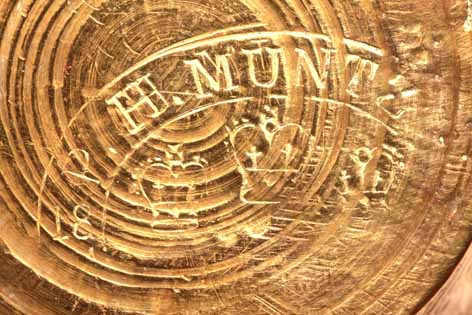
This mark is under a brass beaker richly decorated with a floral pattern of Indian type. It was applied before the base was roughly turned. Presumably the brass was supplied from the stock of sheet held by the Company's Indian depot mainly for ship's cladding.
In 1921 the Company was bought by Elliott's Metal Co. who were in turn taken over by ICI Metals Division (later IMI) in 1928. Company papers from 1863-1928 are lodged with Birmingham Central Library covering their bus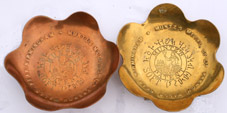 iness also making copper and brass tube.
iness also making copper and brass tube.
These are examples of promotional ashtrays, one in copper and the other brass.
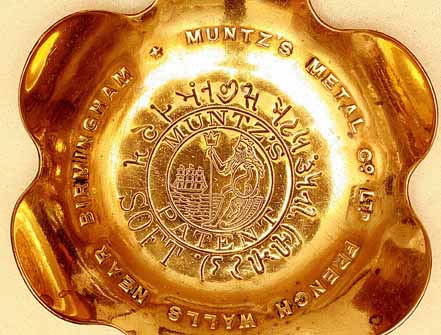
A closer look shows that Muntz included a description in an Asiatic language outside the central figure of Neptune guarding a three-masted ship of the day.
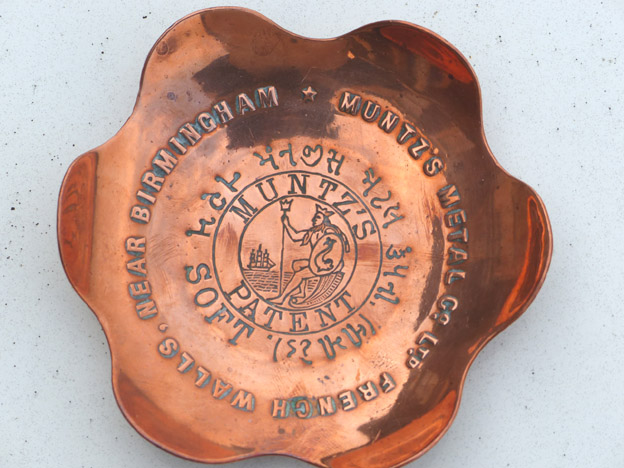
The script is in Gujarati, the main language of the north-western Indian provinces and the tongue of the erstwhile Parsis (prolific businessmen in the 19thC and agents of the East India Company in the 18thC). It is a literal transliteration of Muntz's Metal Company (Limited) and then next to the word SOFT is 'naram', (a transliteration of) the Gujarati word for soft. This is engraved 'upside down' compared to the rest of the inscription. (Thanks to Tehmina Goslar).
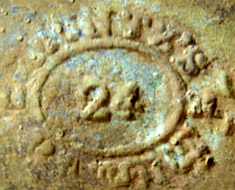
Muntz's Patent oval stamp found on the sheathing of the American clipper ship 'Snow Squall' (1851-1864) after recovery of parts of the wreck from the harbour at Stanley, Falkland Islands. The '24' in the centre of the oval is repeated either side and stands for the thickness of 24oz/ft2 .
Credit: Maine Maritime Museum, paper 'Technical Analysis of Muntz Metal Sheathing from the American Clipper Ship 'Snow Squall (1851-1864)' presented at ICMC 'Metal 2010' http://wlasch.com/CCC_Program_final.pdf
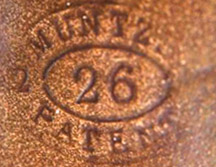 Muntz's Patent oval maker's stamp found on the sheathing copper of the Tasmanian-built bark 'Petrel' (1847-1853) . The wreck resurfaced on Hope Beach, South Arm, Tasmania in July 2006. The '26' records the thickness of copper used for this plate, 26oz/ft2 . Courtesy Peta Knott, Tasmanian Maritime Museum.
Muntz's Patent oval maker's stamp found on the sheathing copper of the Tasmanian-built bark 'Petrel' (1847-1853) . The wreck resurfaced on Hope Beach, South Arm, Tasmania in July 2006. The '26' records the thickness of copper used for this plate, 26oz/ft2 . Courtesy Peta Knott, Tasmanian Maritime Museum.
For a comparative list of thicknesses of copper sheet see HMS Victory Copper Sheathing. For Muntz Metal brass allow for the difference in density between copper and brass.